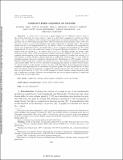Conflict-Free Coloring of Graphs
Author(s)
Abel, Zachary R; Alvarez, Victor; Demaine, Erik D; Fekete, Sándor P.; Gour, Aman; Hesterberg, Adam Classen; Keldenich, Phillip; Scheffer, Christian; ... Show more Show less
DownloadPublished version (753.7Kb)
Terms of use
Metadata
Show full item recordAbstract
A conflict-free k-coloring of a graph assigns one of k different colors to some of the vertices such that, for every vertex v, there is a color that is assigned to exactly one vertex among v and v's neighbors. Such colorings have applications in wireless networking, robotics, and geometry and are well studied in graph theory. Here we study the natural problem of the conflict-free chromatic number χCF(G) (the smallest k for which conflict-free k-colorings exist). We provide results both for closed neighborhoods N[v], for which a vertex v is a member of its neighborhood, and for open neighborhoods N(v), for which vertex v is not a member of its neighborhood. For closed neighborhoods, we prove the conflict-free variant of the famous Hadwiger Conjecture: If an arbitrary graph G does not contain K [subscript k+1] as a minor, then χCF(G) ≤ k. For planar graphs, we obtain a tight worst-case bound: three colors are sometimes necessary and always sufficient. In addition, we give a complete characterization of the algorithmic/computational complexity of conflict-free coloring. It is NP-complete to decide whether a planar graph has a conflict-free coloring with one color, while for outerplanar graphs, this can be decided in polynomial time. Furthermore, it is NP-complete to decide whether a planar graph has a conflict-free coloring with two colors, while for outerplanar graphs, two colors always suffice. For the bicriteria problem of minimizing the number of colored vertices subject to a given bound k on the number of colors, we give a full algorithmic characterization in terms of complexity and approximation for outerplanar and planar graphs. For open neighborhoods, we show that every planar bipartite graph has a conflict-free coloring with at most four colors; on the other hand, we prove that for k ∈ {1,2,3}, it is NP-complete to decide whether a planar bipartite graph has a conflict-free k-coloring. Moreover, we establish that any general planar graph has a conflict-free coloring with at most eight colors. Keywords: conflict-free coloring; planar graphs; complexity; worst-case bound
Date issued
2018-11-27Department
Massachusetts Institute of Technology. Department of Mathematics; Massachusetts Institute of Technology. Computer Science and Artificial Intelligence LaboratoryJournal
SIAM Journal on Discrete Mathematics
Publisher
Society for Industrial & Applied Mathematics
Citation
Abel, Zachary et al. "Conflict-Free Coloring of Graphs." SIAM Journal on Discrete Mathematics 32, 4 (2018): 2675–2702 © 2018 The Author(s)
Version: Final published version
ISSN
0895-4801
1095-7146